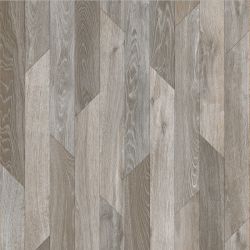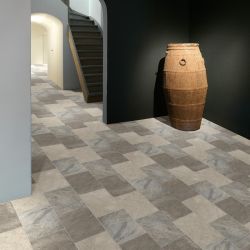Why You Might Want Felt Backed Vinyl as Your Flooring Choice
Vinyl flooring is available in more ways than one. Different materials are used to construct different forms of vinyl flooring which is unknown by many. These different materials are used because they all provide a different strength that makes them best suited for different purposes. Not all vinyl is used in homes as waterproof bathroom flooring. There are some that are used commercially in offices or as hospital flooring and these require them to be sturdier and more tolerant of heavy foot traffic. An alternative to regular vinyl, which is made with a polypropylene backing, is felt-backed vinyl. The benefits that come from using felt-backed vinyl can be very beneficial for households and prove to be a must-have.

Beauflor Derby 162M Tile Effect Anti Slip Luxury Vinyl Flooring
When looking at the materials themselves, felt is very different from polypropylene. While polypropylene is essentially a thermoplastic, felt is more porous because it is a textile material. This allows the felt to stick better to the subfloor and move around less. Having the vinyl glued down to the sub-floor is not always a requirement when the vinyl is a large sheet that is, but it is when there are individual tiles laid down. You would want these tiles to be in place rather than loose and moving around. The felt backing is made from textile fibers that don’t tear as easily, compared to other types of vinyl, when cut into. This is a greater strength as it means that felt-backed vinyl is more dimensionally stable and can withstand cuts and tears. This is an added bonus as it means it can last longer under heavy foot traffic. With this longevity, felt-backed vinyl is incredible flooring for kitchens.
Because it is more dimensionally stable, felt-backed vinyl can be easier to install, onto the subfloors compared to other vinyl variations. Since it is a vinyl variation, it is not different from the places that it is best suited. All vinyl regardless of its added properties is highly recommended to be put into splash zones. These wet places, which are the bathroom and kitchen areas of the house are required to have flooring that is mostly unaffected by water and can allow easy clean-up. Splashes and spillages are not an occasional thing but a regular recurrence, hence why the flooring should be able to tolerate it. The vinyl itself is very resistant to water, but that is if the water states above the wear layer and doesn’t make its way down to the backing. If the water seeps into cracks or down the edges of the vinyl and makes its way to the backing, it can cause the adhesive to weaken. The adhesive keeps the vinyl stuck to the subfloor and prevents it from moving around and becoming loose.
Sometimes, the adhesive is colored, due to its chemical composition, and mixing it with water can cause the chemicals to separate. The color of the adhesive can migrate through the vinyl, color migration, and affect the wear layer of the vinyl. This will result in a large discolored area on the surface of the vinyl which is irreversible and untreatable. The only way to fix it would be to replace the entire vinyl. To ensure that this is avoided or at least kept to a minimum, the edges of the vinyl should be courted with silicone to prevent water from leaking in. This is recommended with all types of vinyl, to ensure that the backing layer is protected and that the adhesive doesn’t weaken.
As mentioned before, felt-back vinyl flooring is more resistant to wearing and tearing in comparison to regular vinyl. When large appliances like fridges and washing machines are being moved, they often have to be lifted rather than dragged because it can cause the vinyl to get caught and tear or cause it to stretch and ripple. Both are what you would want to avoid with vinyl if you want to maintain its appearance and its longevity. This is not the case with felt-backed vinyl as it means that less care and protection are needed. It is not the cast saying that you can drag appliances haphazardly, but as long as the vinyl is secured to the sub-floor with a strong adhesive, it won't be easily affected by moving furniture and appliances around.

Beauflor Derby 162M Tile Effect Anti Slip Luxury Vinyl Flooring
Permanent adhesive is not needed to glue down felt-backed vinyl to the subfloor, especially if the subfloor is adequate and well-prepared. If you are preparing the subfloor using plywood or screed or with whatever is needed, then a permanent fix would be good to ensure the longevity of the vinyl. Felt-backed vinyl can simply be placed down using spray adhesive as it is very porous and can absorb the adhesive much better than regular vinyl. Usually, spray adhesive would not be used, as it is generally not enough, but that is not the case with a felt backing. This is better than using permanent adhesive as it can ruin the subfloor by being stubborn to remove itself when needed, even though it is the best solution at times to glue down the vinyl to the subfloor. If the vinyl is ever to be replaced and permanent adhesive is used, no doubt there will be some residual adhesive that refuses to come off on its own. It will require extra work and solvent to remove it and there is no guarantee that the sub-floor will be in great condition after that.
Vinyl is regarded as a smooth surface flooring choice as it is level and not made from textile material like carpet. With this in mind, you don’t want your vinyl to be too smooth which makes it impossible to have any grip or friction when walking. Felt-backed vinyl has a standard slip-resistant of R10 which means that it is good to stall for kids and pets to avoid slips and accidents. When choosing a vinyl there should be a balance between wanting slip-resistance and it being good for cleaning. To make vinyl slip-resistant, the texture is added to the surface as either small sand bumps or as little crevices. The crevices make it harder for it to be cleaned as they can collect dust and dirt. Over time, this build-up can lead to a faded and dirty look on the vinyl. It is to be expected that there will be high dust counts with high slip-resistant vinyl. On the other side, if vinyl is very easy to clean, it most likely means that there is very low slip resistance.

One of the known drawbacks of felt-backed vinyl is the cost of the vinyl itself. It costs more to have felt-backed vinyl installed than any other vinyl and this can be a deciding factor when you are on a budget and want something more cost-effective. On the flip side, if you are not wanting to prepare the subfloor adequately or if there are small bumps and crevices, felt-back vinyl can be used to cover up the imperfections. Without spending on the subfloor, it can be spent on felt-backed vinyl. It can cushion over the holes and appear smooth and flat even when the subfloor is not. This is because the felt is a little more forgiving and can cover up the holes better than other types of vinyl can. This does not go the same for larger dents and holes, the subfloor will have to be prepared so that the vinyl’s longevity is not affected by it.
Also, if you are looking for good options for Rugs and Artificial Grass, please click below to visit:







